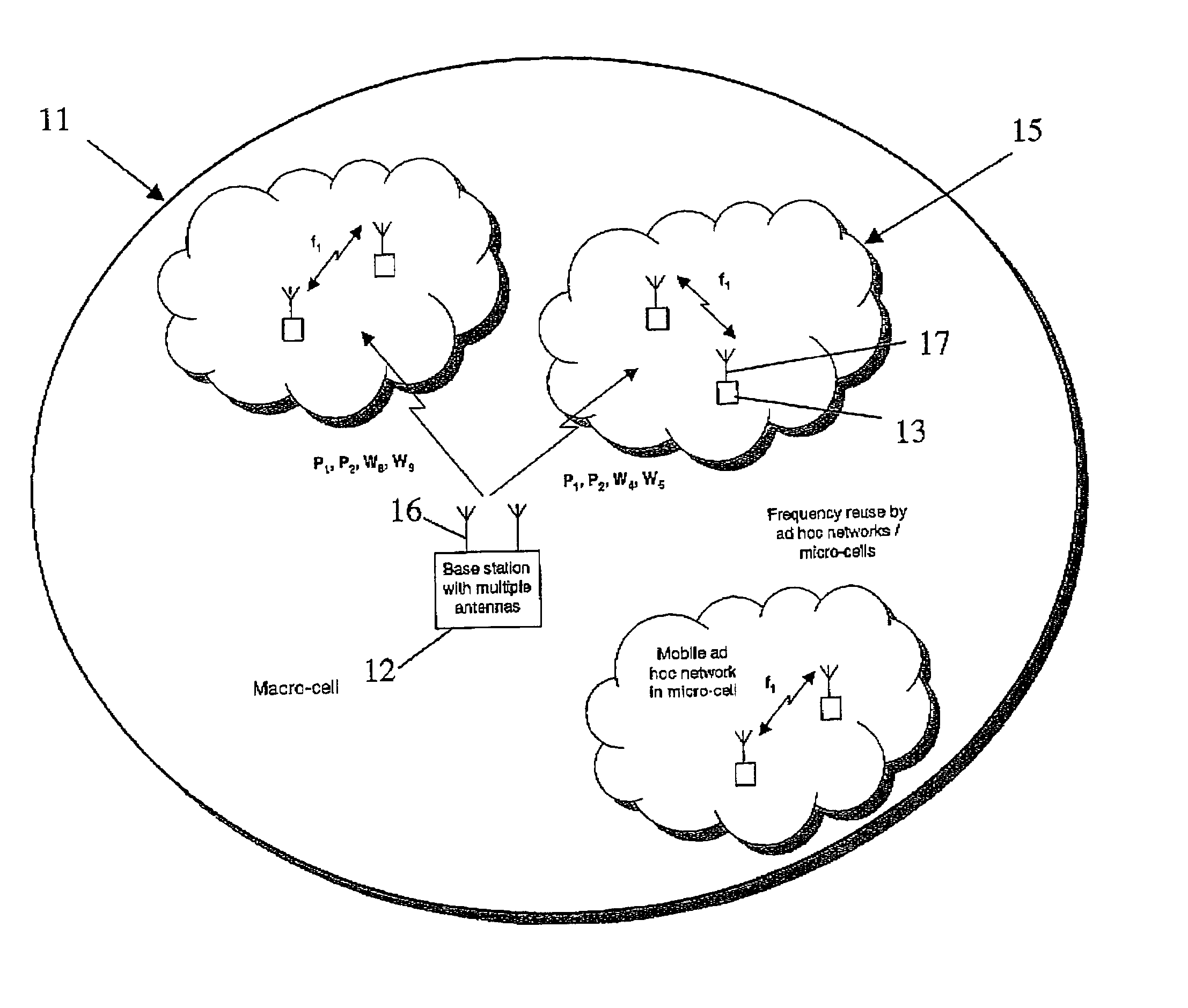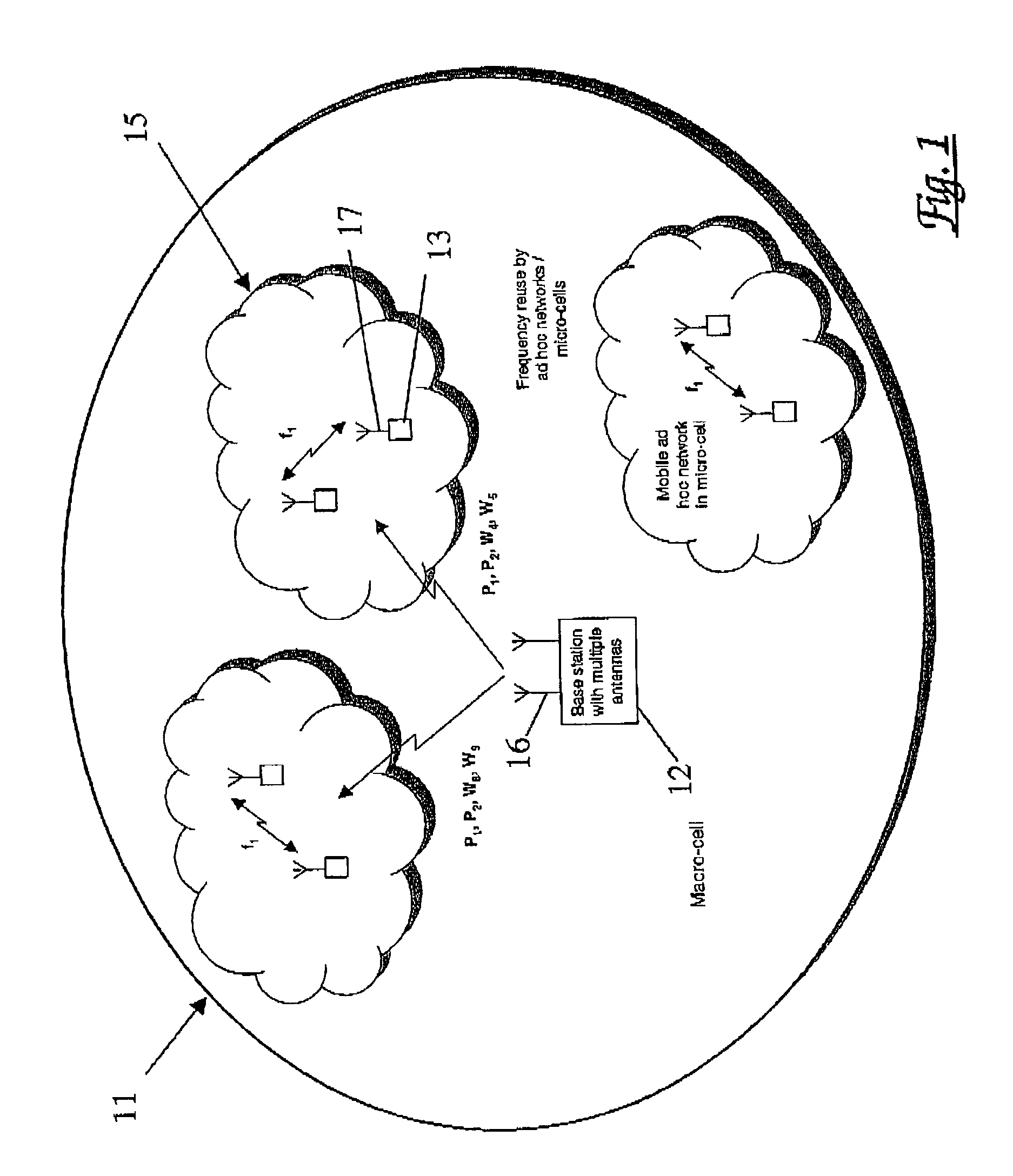Wireless communications system and method
a wireless communication and wireless technology, applied in the field of wireless communication systems and methods, can solve the problems of limiting the application of spatial processing to higher frequencies and/or larger antenna installations, increasing the pressure on the restricted amount of radio spectrum, and diversity gain, so as to facilitate the recovery of signals intended, reduce channel distortion, and improve spectral efficiency
- Summary
- Abstract
- Description
- Claims
- Application Information
AI Technical Summary
Benefits of technology
Problems solved by technology
Method used
Image
Examples
example 2
[0109] The transmitter is distributed, so that several terminals, each equipped with a single antenna, cooperate to enhance the signal transmitted to a multi-antenna base station. In this scenario, additional spectrum is required for communication between the cooperating terminals. The other terminals in the micro-cell are assumed to be similarly engaged in their own sessions, in addition to the signals required to be received and transmitted in respect of the first mobile terminal. Intra-cell communication is assumed to be digital.
[0110] For each bit of a signal from transmitter T to receiver R, 1 / m space-time symbols are transmitted. The relevant component of each of these space-time symbols must be passed from transmitter T to each of the m-1 other cooperating terminals in the group. These components are hard, rather than soft, symbols and so are encoded as {1, -1}, or one bit per symbol. Therefore, the total number of bits that must be transmitted by transmitter T to the (m-1) t...
example 3
[0119] EXAMPLE 3
[0120] Both the transmit and the receive ends of the link are distributed, consisting of groups of cooperating terminals, in which each terminal is equipped with a single antenna. In this scenario, additional spectrum is required for communication between the cooperating terminals at both the transmitter and the receiver.
[0121] In this case, the proportion of the total spectrum required at the receive end of the link for intra-group communication is given by equations 8 and 9. At the transmit end, the corresponding proportion of the spectrum is described by equations 15 and 16. The total proportion of the spectrum that must be set aside for communication within the transmit terminal group and within the receive terminal group is the sum of the respective amounts, leading to 15 Rx S + Tx S = 1 1 + Rx+ 1 1 + Tx where Equation 19 Rx = 1 / ( 1 + m F ) m ( m - 1 ) log 2( k SNR 1 , 1) W S and Equation 20 Tx = 1 / m ( m - 1 ) W S Equation 21
[0122] Hence, the capacity gain t...
example 4
Distributed Receiver
[0127] We noted above that if cooperation is with idle terminals, rather than those engaged in their own sessions, the factor 1 / n in equation 5 and the factor 1 / m on the RHS of equation 7, do not apply. Although the total spectrum available for intra-terminal communication is given by 17 S = 1 1 + Equation 23
[0128] as before, the definition of a changes and equation 9 becomes 18 = 1 / ( 1 + m 2 F ) ( m - 1 ) log 2( k SNR 1 , 1) W S Equation 24
[0129] The relative capacity for a distributed system with m=n, then becomes 19 C m , nC 1 , 1= m ( 1 - 1 1 + ) Equation 25 C m , nC 1 , 1= m ( 1 1 + ( 1 + m 2 F ) ( m - 1 ) log 2( k SNR 1 , 1) W S ) Equation 26
[0130] The performance is shown in FIG. 9, which shows that the overall capacity gain is still dominated by the frequency re-use and spectral allocation, wherein:
4 Line F .kappa. SNR W .phi. S 91 100 10 10 10 4 1250 92 100 10 10 10 4 5000 93 1000 10 10 10 4 5000 94 1000 4 10 10 4 5000 95 1000 4 5 10 4 5000 96 1000 4 5...
PUM
 Login to View More
Login to View More Abstract
Description
Claims
Application Information
 Login to View More
Login to View More - R&D
- Intellectual Property
- Life Sciences
- Materials
- Tech Scout
- Unparalleled Data Quality
- Higher Quality Content
- 60% Fewer Hallucinations
Browse by: Latest US Patents, China's latest patents, Technical Efficacy Thesaurus, Application Domain, Technology Topic, Popular Technical Reports.
© 2025 PatSnap. All rights reserved.Legal|Privacy policy|Modern Slavery Act Transparency Statement|Sitemap|About US| Contact US: help@patsnap.com



